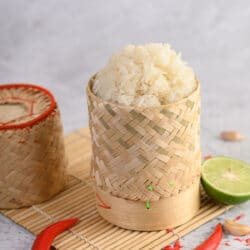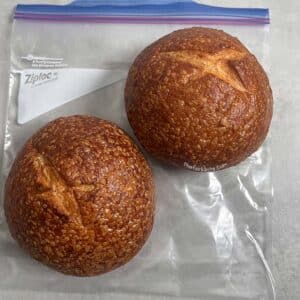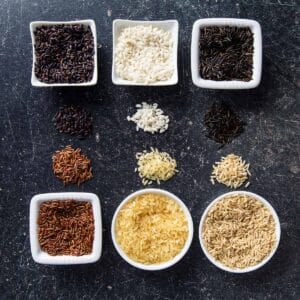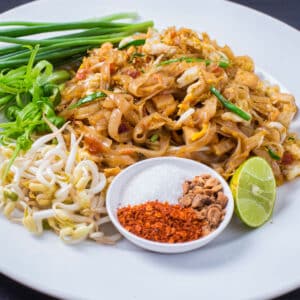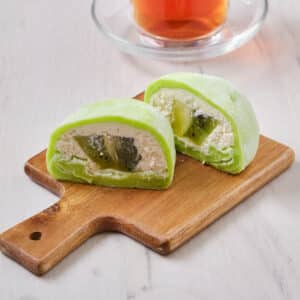What if you knew how to reheat cooked sticky rice, so it's just as good as when you first cooked it? Would you then be tempted to store it and use it later?
If you would, I will tell you how to do just that, so please read on.
When pouring out uncooked rice in preparation for cooking sticky rice, it's all too easy to pour more than you need. It expands as it cooks, and what looks like a relatively small portion of uncooked rice turns into a giant portion of sticky rice once cooked.
Like many other foods, rice will go off after a while, so throwing any leftovers into the bin is tempting, especially when people think that reheating it will make it less sticky and less al dente. But what a waste.
So what's the secret?
Short answer. Steaming is by far the best way to reheat sticky rice. All you have to do is prepare your steamer, fill some water and bring it to a boil. Once boiling, turn it down to simmer. Break the cooked sticky rice up to get rid of clumps and arrange it into a deep bowl—place into a steamer.
Put the lid on and steam for approximately four to five minutes. You can also reheat it in the microwave.
Once you finish reading this article, you will know the best way to reheat sticky rice, so you'll never waste any leftovers again.
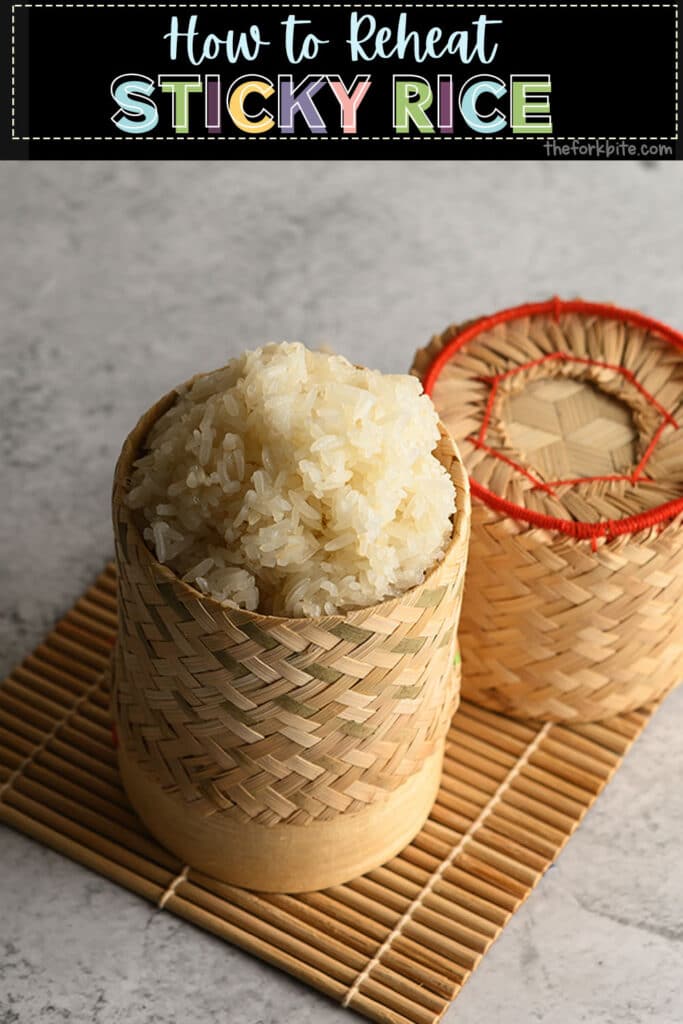
How to reheat sticky rice
Because many people reheat sticky rice the wrong way, they end up with a dry, clumpy mess that is not pleasant to eat. But if you follow the steps and tips below, you can reheat sticky rice, so it's just as good as it was the first time around.
Based on my experience, the best way to reheat sticky rice is to steam it. Transfer the cooked sticky rice into a steamer and break it up to avoid clumps.
Spread it out thinly, cover, and steam for five to ten minutes until reheated. You'll find it won't have lost its "al-dente" texture, nor will it be dry. It will still taste good too.
3 different ways you can reheat sticky rice
I enjoy my sticky rice cooked al dente. Since we have three options, the method of your choice will depend on the quantity of rice you want to reheat.
You can either choose one of these:
- reheat in a steamer
- using a microwave
- warm in the rice cooker
Tips to make reheated rice tastes good.
Reheating rice involves patience and a watchful eye. Follow these tips if you aim to preserve the texture of the leftover sticky rice—or any cooked grain.
- Reheat rice in batches if reheating for more than two or three servings. Don't attempt to reheat a generous amount of rice outright if possible. If you do, there's a possibility that you end up with unevenly reheated rice.
- Drape your sticky rice with a moist or dampened paper towel when reheating in a microwave. Wrapping it this way will lock in the moisture that yields fluffy rice.
- Try not to overcook when reheating rice in a steamer. The intention is to warm the rice to a certain extent or a tad warmer than room temperature.
- Only reheat rice once. Further than that, you risk exposing the rice to bacterial growth that could harm your body.
How do you make rice taste good the next day?
The key to getting next-day fluffy rice is reheating it with plenty of moisture, so steaming is the perfect option! Add the rice into a small deep bowl and pour slowly and evenly two tablespoons of broth or water for every bowl of rice. You can also add a pat of butter for extra richness.
How to reheat sticky rice without drying it out?
Nobody wants a bowl of moistureless sticky rice. Introducing water helps to rehydrate and plump the rice up as it warms. To ensure it doesn't dry out, you can sprinkle a bit of water when reheating.
- If you're reheating in the microwave, transfer the rice into a microwave-safe bowl and sprinkle over two tablespoon of water for every cup of rice.
- Loosely cover it with a lid or damp paper towel. This manner will create a steaming effect while locking in the moisture.
As with any starchy food you reheat in the microwave, sticky rice tends to reheat unevenly. The best way of preventing this is to stop halfway through the cooking time, stir the rice with the fork, and then continue reheating.
1 How to reheat sticky rice in the microwave
If you're up against the clock, using the microwave to reheat sticky rice is the best way of doing it quickly. However, you can use whichever one of the following methods you prefer to do it right, so the rice doesn't dry out.
Remember, it is imperative to reheat the rice at a temperature recommended by the USDA to a minimum of 165°F for safety.
With a paper towel:
Step 1
Transfer the sticky rice to a microwave-safe plate and spread it into an even layer.
Step 2
Lightly moisten a sheet of paper kitchen towel and drape over the rice. (Optional, but I do it all the time: Fill a small heatproof container with ¼ cup of water and put it next to the plate).
Step 3
Nuke at 30-second intervals for two minutes, depending on how many servings of rice you are reheating. Check intermittently between intervals to ensure the rice has reheated evenly.
With Plastic Wrap:
Step 1
Ladle out sticky rice into a microwave-safe deep bowl dish, ensuring ample space for steaming.
Step 2
You can drizzle two or three tablespoon of water over a bowl of sticky rice. If you crave an extra flavor, try adding chicken or beef broth instead of water.
Step 3
Encase plastic wrap over the wider shallow bowl. Don't let the saran or cling wrap touch the actual food. Pierce some small holes to avoid pressure buildup.
Step 4
Zap on high for 30 seconds burst until warmed through, stirring the rice amid the breaks to guarantee even heating.
Step 5
Take the plastic wrap off cautiously to shun the steam deserting from the bowl.
Step 6
Mix and stir the sticky rice to evenly distribute the heat on every piece.
With a Glass of Water:
Step 1
Place the rice onto a deep bowl or into a wide shallow bowl. Fill a small glass with ¼ cup of water and position it next to the bowl.
Step 2
Nuke the rice at 30 seconds intervals for 1 minute or two. Check the rice occasionally between intervals to ensure evenly reheated; microwave again if it's still cold.
The ice cube method
The ice cube hack works just the same as sprinkling water over the rice, but it has the advantage of helping to ensure you don't add too much or too little water.
Step 1
Arrange the sticky rice into the deep, microwave-safe bowl.
Position one ice cube over the rice before zapping it in the microwave. If you're reheating two or more servings, you may need to add one or two more cubes.
Step 2
Drape a sheet of paper towel or parchment paper over the rice before you start nuking to keep the moisture in and assist the steaming process.
If you haven't done this before, you'll be surprised to notice that the ice cube hasn't melted. However, your rice should be nice and warm, and moist.
Step 3
Remove the ice cube immediately and serve the reheated rice.
How does it work?
It's all about the steaming process. It takes a few water molecules from the ice cube and reintroduces moisture to the sticky rice, helping it reheat without drying out.
The temperature of the ice cube hasn't changed significantly enough to make it melt—the wonders of chemistry.
Extra Tip:
- If you're serving your reheated sticky rice with a savory dish, you can add chicken stock to impart a little flavor boost rather than water before microwaving.
- Don't forget to check periodically while the rice is warming through to ensure it doesn't overheat and dry out.
- Make sure NOT to reheat too much sticky rice at once. Otherwise, you'll come up with unevenly heated rice. My recommendation is no more than two heaped cups of rice per session.
2 Reheating sticky rice in a steamer
If a steamer is not available, you can use a substitute steamer on deck. Apply this hack using a make-shift steamer with tinfoil and a heatproof plate to steam rice, veggies, or fish.
How to reheat sticky rice in a steamer
- Prepare the steamer, boil the water and simmer down the heat.
- While waiting for the water to boil, scoop the sticky rice into a plate and crumble up any lumps.
- Transfer the bowl of sticky rice to the steamer, then spread the rice to form one thin layer.
- Put the steamer lid in place and cook for five minutes.
If you a steamer is not accessible, you can fashion a DIY one by following these steps:
- Position a large saucepan or casserole on your stovetop.
- Grab some aluminum foil and create three or four proportionate tinfoil balls for stability.
- Stick the balls on the saucepan, and place a plate on top of them.
- Meanwhile, if any, split the lumps, then transfer the sticky rice onto the plate.
- Fill the pot with water to a depth of one inch. Let the water boil and scale back the heat to bring the liquid to a simmer.
- Put the lid on and steam the sticky rice for 6 minutes.
I prefer simmering rather than boiling because less agitation means the rice won't break apart but yield a lovely texture. Keeping the water at a simmer means warming the rice rather than cooking it.
The result
Whenever I reheat sticky rice this way, it has a superb texture. It's hot, sticky, and moist. Exactly how I like it.
It's a bit more laborious than going down the microwave route, but to my mind, the result is well worth the extra effort. It's also favorable when reheating three or more servings of rice which is sizable for the microwave.
3 Reheating sticky rice in a rice cooker
I once left my rice cooker on for 18 hours. I didn't mean to. Of course, it was an oversight. I'd taken out what I wanted and left the leftover there but forgot to switch it off.
I finally realized what I'd done, and when I checked the rice, it hadn't burnt, but it was as dry as the Sahara.
I wouldn't have chanced eating it anyway, not knowing whether the rice had kept it above the temperature danger zone (between 40°F -140°F).
To reheat properly in a rice cooker, follow these steps:
Transfer the sticky rice to the rice cooker, breaking up any clumps as you go.
Step 1
Place the leftover rice into the rice cooker. Sprinkle two or three tablespoon of water to maintain the moisture. Put the lid back.
Step 2
Adjust the rice cooker to a "warm" setting and reheat for 6 to 8 minutes or until the rice is evenly reheated.
The result
I must say that I was pleasantly amazed. I didn't realize it worked efficiently as well. If you're reheating sticky rice just for one or two people, this rice cooker method is perfect.
The proper way to store cooked sticky rice
The key to preventing bacteria from developing in freshly cooked sticky rice is to cool it down before storage. You can speed up the cooling process by spreading the hot rice thinly on a tray or baking sheet.
Once it has cooled down, you can transfer it into an airtight container and return it to the fridge. You can store it safely in this way in the refrigerator for three to four days.
I often store my sticky rice either in a Tupperware-type container with the lid sealed in place, or a Ziploc bag, from which I evacuate as much air as possible before closing.
Suppose you're using an open plate or tray to store your rice. Try covering it with plastic food wrap to prevent it from becoming dehydrated.
Spreading out thinly helps the rice to lose heat quickly, which is necessary as you don't want to sit it out at room temperature for longer than two hours.
Although you can keep cooked sticky rice in your fridge for up to four days, the longer it stays, the less sticky it becomes, so it's best to eat rice straight away or store it in the freezer.
Read:
Can you freeze sticky rice?
Sure you can. I'm more partial to storing rice in the freezer because it freezes beautifully. Freezing food is quintessential in stretching its life span. You can keep it in a tightly sealed container and stow it for two months. Longer than that, the quality will deteriorate, and when you reheat it, you'll find it will be dry.
How to freeze sticky rice
- Once you become aware that you're not going to eat the leftover sticky rice, be ready to store it.
- The first thing to do is to cool the rice at room temperature. Use a baking sheet and spread it out in a thin layer.
- Once it cooled down, allocate per serving for easy access when it's time to reheat.
- Place in a top zip bag or airtight container and place in the freezer.
- Consume the rice within two months for freshness. Otherwise, the quality will diminish if you leave it longer than that period.
Extra tips when freezing sticky rice
There are many good reasons to squeeze out air when storing food in a Ziploc bag as much as possible. The better way of doing it is to put the food in the bag and seal it out most of the way, leaving just an inch of space.
Then, proceed by putting your mouth on that inch space and sucking all the air out. Doing this takes up less space, and you can throw the bag in the freezer.
Obviously, not a trick that works for rice only. It works for nearly anything you ever want to put in a Ziploc bag. Watch the Ziplock bag trick here
- As I am quite a thrifty person, I often freeze leftovers, and the quickest and easiest way of packing them for freezing is to use a vacuum sealer. If using a Ziploc-type bag, evacuate as much air as possible.
- Another trick is to immerse the freezer bag in a bowl of water, leaving the opening above the waterline to allow the pressure of the water to force the air out before sealing the bag closed. Here's a simple way of doing this.
- It's also a good idea to store the rice in portion sizes. It's much easier to take out the quantity you need and makes it faster to defrost.
Reheating sticky rice from frozen
I usually reheat frozen sticky rice straight from the freezer. No thawing is necessary. No muss, no fuss if you know the hows.
Step 1
Take the frozen rice out from the freezer and gently break the mounds. My favorite tool for doing this is my rolling pin.
Step 2
Transfer the small chunks of frozen sticky rice into a microwave-safe bowl, drizzle 2 tablespoon of water. Cover the bowl with a damp, moist paper towel.
Step 3
Nuke at 30-second bursts, fluffing it in each interval to defrost it faster until the rice is warmed through. Although it takes longer, an alternative is to use the steamer, and it is worth the effort.
If you have difficulty breaking the rice up, you can warm it slightly in the microwave to soften the lumps a little, enough to allow you to break it up and then continue to reheat.
How long does cooked sticky rice last?
Providing you transfer your sticky rice into an airtight container or bag, you can store it in your fridge for up to four days. The quality does deteriorate with the length of time it is stored. I find it's best to eat it within two days to enjoy it at its best quality.
As long as you keep it away from any moisture, you can store uncooked sticky rice for up to a year, so there's no need to think you have to cook it and freeze it to extend its storage life.
Sticky Rice vs. Other White Rice
Non-sticky rice contains two different varieties of starch - amylose and amylopectin. It is the proportion of these two types of starch that determine the stickiness of the rice.
Non-sticky, long-grain white rice has a higher amylose content - between 19% and 23%, making it more fluffy.
Short grain white rice has a lower amylose content - between 12% and 19%, which causes the grains to stick to each other.
On the other hand, sticky rice contains a maximum of 1% amylose and high levels of amylopectin. This proportion gives the rice its glorious stickiness when cooked.
Read: Sushi Rice vs Sticky Rice
Where to buy sticky rice
When you go shopping for sticky rice, shop for Thai rice. Sticky rice differs from ordinary rice, so you need to know what to look for. Search for rice labeled as "glutinous rice" or Thai sweet rice.
I recommend going for Thai brands such as Three Horses or Rose. Unfortunately, it is more expensive than regular rice - anywhere up to twice as costly, but it is worth paying the extra if you want the real stuff.
Why plain regular rice won't work?
As explained here, all grains or rice have two distinctive starch identified as amylose and amylopectin. Ordinary rice contains a higher amount of amylose. On the contrary, sticky rice includes 1% of amylose at most. The insufficiency of Amylose starch is the pretext for making the rice cling together when cooked.
Even if you try boiling ordinary grains, it will never become authentic sticky rice. It just becomes a stodgy, glutinous mess. The grains must contain less percent of amylose to stick together when cooked.
Dishes that are great with an accompaniment of sticky rice
You can use sticky rice to make a variety of dishes, including:
- Desserts
- In a stuffing for roast chicken shumai, zongzi, and similar type dumplings
The standard practice in Chinese cuisine is to use long-grain sticky rice for savory dishes and short-grain for desserts.
Sticky rice long grains are firmer and less sticky than short-grain, so they work well in savory dishes. The stickiness of short-grain rice is more suited for desserts like Chinese rice pudding or sweet rice cake.
What sticky rice tastes like
You'll sometimes see sticky rice labeled as Thai sweet rice, and unsurprisingly this is because it has a slightly sweet taste.
They're popular ingredients in many dessert recipes, but it is more recognized for their glorious, sticky texture. However, don't imagine it is sweet as in rice pudding. It's only marginally sweet when compared to ordinary rice.
Where to buy sticky rice
Because it has grown in popularity in recent years, you'll find sticky rice on sale in many supermarkets, either in their international aisles or displayed on shelves and other types of rice.
You can purchase it as well in Chinese and Asian markets. Another option is to buy it online.
Sticky rice is sometimes labeled as glutinous, Mochi, pearl, or waxy. It is also available un-milled in black and purple varieties.
Storing uncooked sticky rice
Uncooked sticky rice is typically sold in plastic packaging and can be stored almost indefinitely, providing the contents are well-sealed and kept away from any moisture. You can store it in your freezer, fridge, or pantry.
It's crucial to cool sticky rice as quickly as possible once it's cooked because the uncooked grains contain bacteria that can reproduce rapidly, even after boiling.
The best way to cool cooked sticky rice quickly is to spread it thinly onto a baking sheet and store it in your fridge. Once it's properly cooled, you can transfer it into an airtight container and leave it in your fridge for up to four days or in your freezer for up to 2 months.
Step by step instructions how to reheat sticky rice
Pin RecipeEquipments:
- stovetop
- Microwave
- Rice Cooker
Instructions:
#1 How to reheat sticky rice in the microwave
With a paper towel:
- Transfer the sticky rice to a microwave-safe plate and spread it into an even layer.
- Lightly moisten a sheet of paper kitchen towel and drape over the rice. (Optional, but I do it all the time: Fill a small heatproof container with ¼ cup of water and put it next to the plate).
- Nuke at 30-second intervals for two minutes, depending on how many servings of rice you are reheating. Check intermittently between intervals to ensure the rice has reheated evenly.
With plastic wrap:
- Ladle out sticky rice into a microwave-safe deep bowl dish, ensuring ample space for steaming.
- You can drizzle two or three tablespoon of water over a bowl of sticky rice. If you crave an extra flavor, try adding chicken or beef broth instead of water.
- Encase plastic wrap over the wider shallow bowl. Don’t let the saran or cling wrap touch the actual food. Pierce some small holes to avoid pressure buildup.
- Zap on high for 30 seconds burst until warmed through, stirring the rice amid the breaks to guarantee even heating.
- Take the plastic wrap off cautiously to shun the steam deserting from the bowl.
- Mix and stir the sticky rice to evenly distribute the heat on every piece.
The ice cube method:
- Arrange the sticky rice into the deep, microwave-safe bowl.Position one ice cube over the rice before zapping it in the microwave. If you’re reheating two or more servings, you may need to add one or two more cubes.
- Drape a sheet of paper towel or parchment paper over the rice before you start nuking to keep the moisture in and assist the steaming process.If you haven’t done this before, you’ll be surprised to notice that the ice cube hasn’t melted. However, your rice should be nice and warm, and moist.
- Remove the ice cube immediately and serve the reheated rice.
#2 Reheating sticky rice in a steamer
- Prepare the steamer, boil the water and simmer down the heat.
- While waiting for the water to boil, scoop the sticky rice into a plate and crumble up any lumps.
- Transfer the bowl of sticky rice to the steamer, then spread the rice to form one thin layer.
- Put the steamer lid in place and cook for five minutes.
#3 Reheating sticky rice in a rice cooker
- Place the leftover rice into the rice cooker. Sprinkle two or three tablespoon of water to maintain the moisture. Put the lid back.
- Adjust the rice cooker to a “warm” setting and reheat for 6 to 8 minutes or until the rice is evenly reheated.
Notes:
Extra tip:
- If you’re serving your reheated sticky rice with a savory dish, you can add chicken stock to impart a little flavor boost rather than water before microwaving.
- Don’t forget to check periodically while the rice is warming through to ensure it doesn’t overheat and dry out.
- Make sure NOT to reheat too much sticky rice at once. Otherwise, you’ll come up with unevenly heated rice. My recommendation is no more than two heaped cups of rice per session.
Please note that all nutrition information are just estimates. Values will vary among brands, so we encourage you to calculate these on your own for most accurate results.

